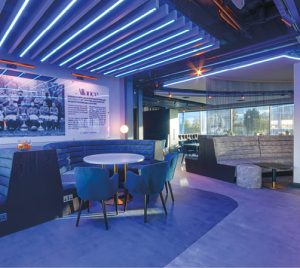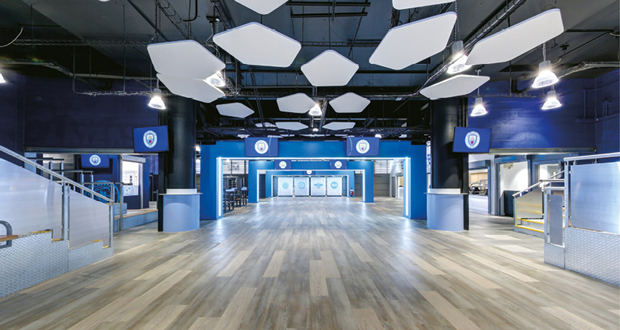PREPARATION AND STORAGE
Efficient preparation and storage areas will prevent delays and support a smooth flow of service. Designated storage spaces for food, beverages and equipment should be placed close to the service areas for easy access. This reduces downtime for staff and positions supplies to be readily available during peak times.
For larger stadiums, this could mean creating separate storage areas for different hospitality outlets or suites to avoid overstocking one area while leaving another underprepared. The goal is to support staff by providing them with everything they need within arm’s reach.
UTILISING TECHNOLOGY
Modern technology has a substantial impact on the guest experience and operational success in stadium hospitality. Integrating technological solutions into a fit-out can boost service speed, improve guest engagement and create memorable experiences.
- Self-dispense stations: these stations allow guests to serve themselves, reducing wait times and freeing up staff to focus on other areas. For stadiums with large crowds, this is a highly efficient way to manage demand during peak times, while also offering a novelty that guests appreciate.
- Interactive displays: incorporating interactive displays into stadium hospitality areas can create engaging experiences for guests. Whether it’s live updates, social media feeds or gamified content, these displays can keep guests entertained during quieter moments. Some stadiums also use interactive screens to display real-time statistics, which could be particularly appealing to sports enthusiasts.
- Hero walls: these are large display areas designed to captivate attention, often showcasing key moments from past games or featuring a mix of live event footage and promotional content. These feature walls not only engage guests but also help create a sense of identity and history for the stadium. They can be strategically placed in entry areas, bars or suites to add a focal point that elevates the overall experience.
- Speed of service: implementing technologies like QR codes for ordering and paying can streamline processes for guests, particularly in seated areas. Guests can scan a code to order food or drinks directly to their seats, bypassing the need to queue. This method also provides an opportunity to offer personalisation, allowing repeat guests to store preferences for future visits.
TICKET-TO-SEAT CUSTOMER EXPERIENCE
A well-thought-out customer experience integrates both physical and digital elements which streamline the customer’s journey.
- The guest journey: this begins the moment guests enter the stadium. Clear and intuitive wayfinding systems will guide them to their seats or hospitality areas without confusion. Digital signage, interactive maps and mobile apps can all be used to enhance the guest experience, so they spend less time finding their way and more time enjoying the event.
- Clear guidance: signage plays a role in ensuring guests can easily navigate the stadium. Signs should be large, visible and placed at all key decision points, including entrances, bars, restrooms and seating areas. Consistent branding and colour schemes help guide guests effortlessly, reducing stress.
- First impressions: the entrance to a hospitality space sets the tone for the guest experience. Whether it’s a private suite or a communal bar area, design a welcoming entrance that reflects the quality of the space inside. Use design elements such as lighting, artwork and furniture to create an inviting atmosphere from the start.
- Stress-free journey: a stress-free journey is about more than just clear signage; it’s about anticipating guest needs. Offering adequate seating in waiting areas, clear directions to restrooms and a seamless queuing system for food and drink all contribute to an enjoyable experience. These touches show attention to detail and can be the difference between a satisfied and a frustrated guest.







